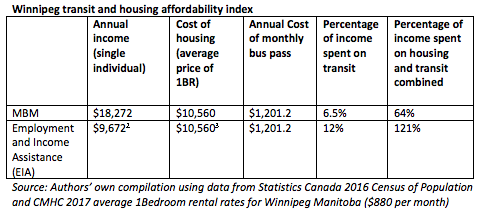By Ellen Smirl
A year after announcing a 25-cent a trip fare increase, mayoral candidate Brian Bowman has promised to create a low-income transit pass if he is re-elected mayor on October 24th. This is great news because waning government support at the provincial level through a funding freeze and the fare increase has led to poor service, unaffordable fares and declining ridership.
Many low-income Winnipeggers and those in the inner city rely on public transit with no other options. Unaffordable transit means not being able to get to work, yet another added cost to already stretched grocery budgets, get to medical appointment or visit friends and families.
Winnipeg Transit fares are currently structured as a flat fee. This means that people with lower incomes are paying proportionately more of their income on fares. The recent fare increase exceeded the rate of inflation and is much greater than any increases in government income assistance programs or the minimum wage rate.

Individuals living at the Market Basket Measures threshold spend 6.5 per cent of their income on taking transit, however when the cost of transit and housing is combined that figure jumps to 64 per cent. Individuals receiving EIA would have to spend more than they receive in order to afford both housing and a transit pass. This means that many Winnipeggers are making trade-offs between getting where they need to go and having a decent place to live.
Ensuring that people can afford to take the bus is an important tool in fighting poverty and improving health outcomes. Additionally, ninety per cent of attacks against bus drivers involve fare disputes which demonstrates that a low-income transit pass will not only make fares more accessible to people living on low-income but also make a safer workplace for drivers.
Lessons learned in other jurisdictions have shown that the structure and design of a low-income pass program determines how effective it is at reducing transit poverty.
Determining eligibility matters. Many community agencies have said that their clients have to repeatedly prove their low-income status to qualify for a variety of subsidies and that this continual need to jump through hoops represents major barriers for their clients. The City of Calgary offers the Fair Entry Program, which is a single application process to access multiple programs and services including the low-income bus pass as well as the recreation fee assistance and the low-cost spay and neuter program. We have also heard that some low-income individuals struggle to prove their identity and some municipalities have allowed discretion for community-based organizations (CBOs) that have good relationships with their clients to administer the passes on an honours-based system.
While most low-income programs generally offer a discount of somewhere around 50 per cent many evaluations of these programs found the cost was still too high for many. Calgary offers a sliding scale of $5.15 to $51.50 per month based on income.
Anyone receiving social assistance should receive a pass at no cost because any amount is too much given the present inadequacy of the basic needs allowance for actually meeting basic needs. This should not result in any reductions in benefits that people currently receive. New refugees should also receive a free pass as is offered in Grande Prairie Alberta.
Through conversations in the community we have heard that kids are not going to school because their families cannot afford a bus pass. Low-income families should receive free bus passes for school-aged children. Other options include investigating the viability of a family-pass. Any fare reduction strategies should not be limited to travelling in off-peak hours, nor certain days of the week.
Finally, the specifics of design of the low-income pass should occur in consultation with community-based organizations (CBOs) who serve the targeted population. Low-income individuals themselves should also be consulted to ensure that the pass meets their needs. CBOs should be involved in the planning, implementation and evaluation stages.
Establishing an affordable transit program is only the first step. Addressing transit poverty and its consequences means creating a transit system that is safe, reliable, accessible and affordable. Fare reduction strategies should not come at the expense of any reduction in service. This will require broad-scale transit investment. This means lobbying the province to restore and increase the 50-50 funding for Winnipeg Transit operations. While the Provincial government recently scrapped the provincial Carbon Tax, the federal backstop will still apply and a portion of this should be invested in public transit.
Finally, the City makes choices about where to invest money. Public transit should be treated as a valuable public service in the same vein as libraries, community and recreation centres, and public health. It is time for the City of Winnipeg to demonstrate leadership on transit affordability while simultaneously advocating for better funding from other levels of government.
Transit and transportation equity and poverty is the focus of the 2018 State of the Inner City Report. Ellen Smirl is the CCPA MB researcher on this report.


